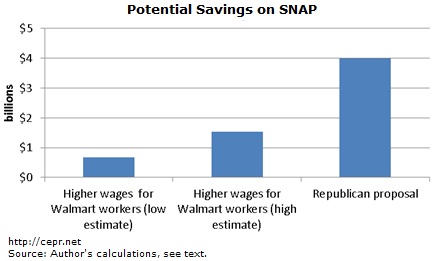September 28, 2013
Last week I blamed the media in general and the New York Times in particular for the battle over the Republican proposal to cut food stamps. The logic is that the media routinely report that the Republicans want to cut $4 billion from the program. Undoubtedly many people hearing this number believe that it constitutes a major expense for the federal government.
The proposed cut to the program is actually equal to just 0.086 percent of federal spending. In other words, it could make a big difference to the people directly affected, but it makes almost no difference in terms of the overall budget. Very few people understand this fact because $4 billion sounds like a lot of money. The media could help to clear up this confusion by reporting the number as a share of the budget, but they don’t do that because — I don’t know.
Anyhow, for those who would like some further context for this proposed cut to the food stamp program we can consider the impact of raising wages on food stamp spending, specifically the wages of Walmart workers. The pay of many Walmart workers is not much above the minimum wage. As a result, a large percentage of Walmart workers qualify for government benefits like food stamps.
By contrast, if the wages of workers at the bottom end of the labor market had kept pace with productivity growth over the last 45 years it would be almost $17.00 an hour today. In that situation, very few Walmart workers would qualify for government benefits.
Earlier this year, the Democratic staff of the House Committee on Education and the Workforce put together calculations for the range of costs to the government through various programs of a Walmart superstore in Wisconsin that employs 300 workers. They put a range for the cost of food stamp benefits for a single store at between $96,000 and $219,500.
According to Fortune Magazine, Walmart has 2.1 million employees nationwide, which means that we should multiply these numbers by 7,000 to get a national total. That puts the annual cost of food stamps for the families of Walmart workers at between $670 million and $1.54 billion. The figure below shows the potential savings to taxpayers from raising the wages of Walmart workers to a level where they don’t qualify for food stamps with the savings from the Republicans’ proposed cuts to the program.

In short, if the goal is to save taxpayers money on food stamps there are different ways of achieving it. One is to cut benefits, as the Republicans have proposed. The other is to increase wages for low-paid workers so that they no longer qualify for benefits like food stamps.







Comments